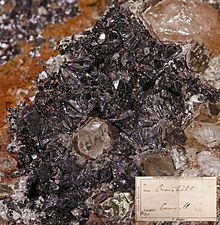| Cronstedtite | |
|---|---|
 Cronstedtite – Salsigne Mine – France Cronstedtite – Salsigne Mine – France | |
| General | |
| Category | Silicate minerals |
| Formula (repeating unit) | Fe 2Fe (Si,Fe O 5)(OH) 4 |
| IMA symbol | Cro |
| Strunz classification | 9.ED.15 |
| Crystal system | Trigonal |
| Crystal class | Ditrigonal pyramidal (3 m) (same H-M symbol) |
| Space group | P31m (no. 157) |
| Unit cell | a = 5.486 Å, c = 7.095 Å; Z = 1 |
| Identification | |
| Color | Black, dark brown-black, green-black |
| Cleavage | Perfect on {001} |
| Tenacity | Elastic |
| Luster | Sub-Metallic |
| Streak | Dark olive green |
| Diaphaneity | Translucent |
| Specific gravity | 3.34 – 3.35 |
| Optical properties | Biaxial (−) |
| Refractive index | nα = 1.720 nβ = 1.800 nγ = 1.800 |
| Birefringence | δ = 0.080 |
| Pleochroism | Visible |
| Dispersion | r < v moderate |
| References | |
Cronstedtite is a complex iron silicate mineral belonging to the serpentine group of minerals. Its chemical formula is Fe
2Fe
(Si,Fe
O
5)(OH)
4.
It was discovered in 1821 and named in honor of Swedish mineralogist Axel Fredrik Cronstedt (1722–1765). It has been found in Bohemia in the Czech Republic and in Cornwall, England.
Cronstedtite is a major constituent of CM chondrites, a carbonaceous chondrite group exhibiting varying degrees of aqueous alteration. Cronstedtite abundance decreases with increasing alteration.

See also
References
- Warr, L.N. (2021). "IMA–CNMNC approved mineral symbols". Mineralogical Magazine. 85 (3): 291–320. Bibcode:2021MinM...85..291W. doi:10.1180/mgm.2021.43. S2CID 235729616.
- ^ Webmineral.com
- Mindat.org
- American Mineralogical Society
- Browning et al. (1996) Geochimica et Cosmochimica Acta
This article about a specific silicate mineral is a stub. You can help Misplaced Pages by expanding it. |